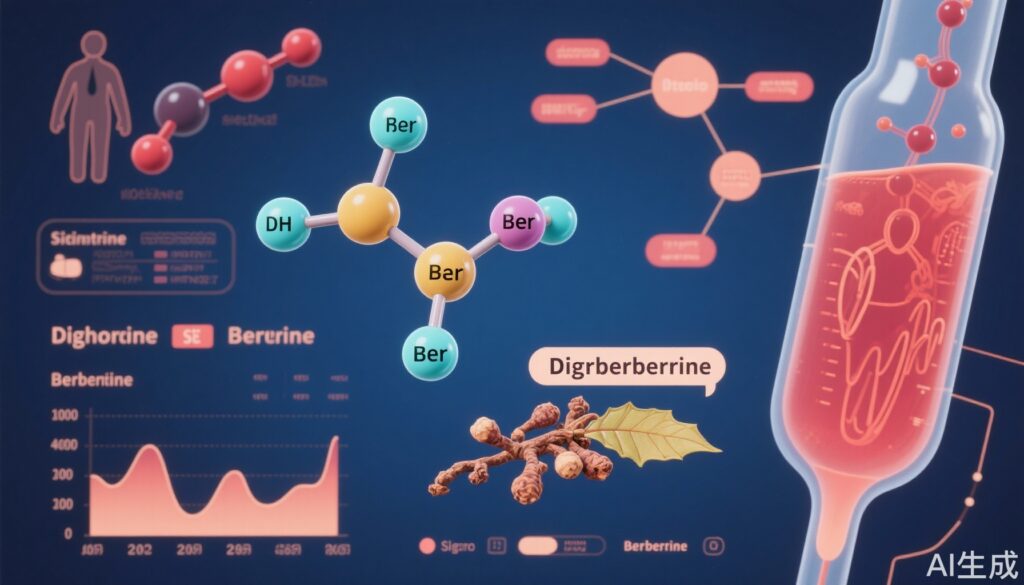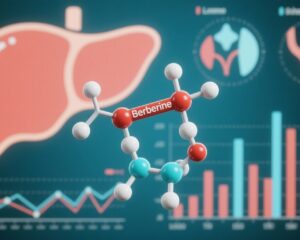Highlights
- Dihydroberberine demonstrates significantly enhanced oral bioavailability compared to berberine, increasing plasma berberine concentrations efficiently.
- Network pharmacology and metabolomics analyses reveal dihydroberberine’s involvement in multiple biochemical pathways, including PI3K-Akt and MAPK, underpinning its therapeutic action.
- Preclinical and clinical pilot studies suggest potential roles of dihydroberberine in metabolic syndrome management and as an adjunct in asthma therapy.
- Despite encouraging pharmacokinetic profiles, clinical efficacy data remain limited, warranting larger, longer-term trials to define its therapeutic scope and safety.
Background
Dihydroberberine, a reduced form of berberine, has garnered growing interest as a therapeutic candidate primarily due to berberine’s well-documented pharmacodynamic benefits but limited bioavailability and dose-dependent gastrointestinal side effects. Berberine is a natural isoquinoline alkaloid traditionally used for metabolic disorders, especially type 2 diabetes mellitus and dyslipidemia. Its poor oral absorption constrains clinical effectiveness. Dihydroberberine, which can be converted in vivo to berberine, is hypothesized to overcome these limitations by improving absorption kinetics and tolerability. Recent research efforts have expanded to explore the molecular mechanisms, pharmacokinetics, and wider clinical applications including respiratory diseases.
Key Content
Pharmacokinetic Advances: Enhanced Absorption and Plasma Concentrations
A randomized, controlled crossover pilot trial published in 2021 (Nutrients, PMID: 35010998) investigated the absorption kinetics of dihydroberberine compared to berberine in healthy male volunteers. The study evaluated four dosing conditions: placebo, 500 mg berberine, and 100 mg and 200 mg dihydroberberine doses administered over a short supplementation period. The results demonstrated that dihydroberberine (D100 and D200) yielded significantly higher plasma berberine concentrations (CMax and area under the curve [AUC]) than 500 mg berberine. Peak concentrations for D100 were statistically different from placebo and berberine, indicating superior bioavailability.
These pharmacokinetic findings highlight dihydroberberine’s potential as a more efficient prodrug of berberine, reducing the required oral dose and potentially minimizing gastrointestinal distress associated with high-dose berberine.
Mechanistic Insights via Metabolomics and Network Pharmacology in Respiratory Disease
A 2022 study (Zhongguo Zhong Yao Za Zhi, PMID: 36604927) explored the anti-asthma therapeutic components of Kechuanting acupoint application therapy (KAAT) using serum metabolomics combined with network pharmacology methodologies. Among multiple identified active components, dihydroberberine was highlighted as a key alkaloid with potential efficacy.
This study identified modulation of metabolic pathways involving glycine, serine, threonine, and glyoxylic acid metabolism. Network pharmacology analysis elucidated dihydroberberine’s action on targets such as serum creatinine kinase (SRC) and matrix metalloproteinase-9 (MMP-9), with downstream effects mediated through PI3K-Akt, MAPK, and calcium signaling pathways. Functional respiratory endpoints, including asthma control test (ACT) scores, forced expiratory volume in 1 second (FEV1), and peak expiratory flow (PEF), were improved in patients receiving KAAT combined with standard therapies.
These data suggest that dihydroberberine may contribute to anti-inflammatory and metabolic regulation mechanisms pertinent to asthma pathophysiology.
Clinical Application Potential
The improved bioavailability profile and mechanistic basis position dihydroberberine as a promising candidate for clinical use in metabolic disorders, particularly diabetes, where berberine traditionally shows glucose-lowering effects but is limited by poor absorption.
The pilot human trial did not detect acute changes in glucose or insulin after short-term administration, which aligns with expectations given the short follow-up and insulin sensitivity of healthy participants, indicating the need for extended investigations in insulin-resistant or diabetic populations.
In respiratory medicine, dihydroberberine as part of herbal combination therapies shows preliminary efficacy signals for asthma symptom control, potentially acting through modulation of inflammatory mediators and intracellular signaling relevant to airway remodeling and hyperresponsiveness.
However, translation into routine clinical practice requires further randomized controlled trials with larger sample sizes, well-defined dosing regimens, and longer follow-up to establish efficacy, safety, and optimal patient populations.
Expert Commentary
The recent 5-year literature demonstrates valuable progress in understanding dihydroberberine’s pharmacokinetics and its potential multifunctional therapeutic roles. Pharmacokinetically, dihydroberberine offers a distinct advantage over berberine with higher and faster systemic availability, thereby potentially reducing dose-related adverse effects.
Mechanistically, the involvement of central metabolic and signal transduction pathways expands its therapeutic scope beyond glycemic control to include anti-inflammatory and airway-modulatory effects, as evidenced by studies integrating metabolomics and network pharmacology.
Despite these advances, clinical research remains nascent. The small sample sizes, short durations, and healthy volunteer cohorts limit conclusions regarding long-term efficacy and safety. Moreover, direct head-to-head efficacy comparisons of dihydroberberine monotherapy versus berberine are lacking in disease populations, as is robust data on its pharmacodynamics, metabolism, and possible off-target effects.
There is also a need for standardized criteria in defining dosing equivalencies and prodrug activation profiles. Regulatory guidance and quality control for dihydroberberine-containing formulations will be critical as clinical research evolves.
Conclusion
In summary, dihydroberberine has emerged as an innovative berberine derivative with improved absorption kinetics and promising multi-target therapeutic effects. Recent mechanistic studies utilizing metabolomics and network pharmacology have underscored its roles in metabolic and inflammatory pathways relevant to diabetes and asthma.
Preliminary clinical trials demonstrate superior plasma exposure compared to berberine, though confirmatory efficacy trials in relevant patient populations are required. The translational potential of dihydroberberine supports further extensive investigations, potentially positioning it as a next-generation therapeutic agent in metabolic and respiratory diseases.
Future research directions include large-scale randomized clinical trials, pharmacodynamic profiling in disease contexts, safety and tolerability assessments, and elucidation of molecular mechanisms underpinning therapeutic effects.
References
- Qie S et al. [Anti-asthma components and mechanism of Kechuanting acupoint application therapy: based on serum metabolomics and network pharmacology]. Zhongguo Zhong Yao Za Zhi. 2022 Dec;47(24):6780-6793. PMID: 36604927
- Illiano E et al. Absorption Kinetics of Berberine and Dihydroberberine and Their Impact on Glycemia: A Randomized, Controlled, Crossover Pilot Trial. Nutrients. 2021 Dec 28;14(1):124. PMID: 35010998



